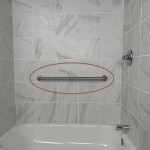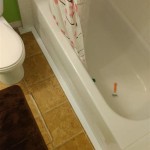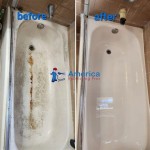Can You Put A Litter Box In The Bathtub? Considerations and Potential Impacts
The question of placing a cat's litter box within a bathtub arises frequently among cat owners, particularly those facing space constraints or seeking innovative solutions for odor control and litter containment. While seemingly practical at first glance, this approach necessitates a thorough evaluation of potential benefits and drawbacks. The suitability of a bathtub as a litter box location hinges on several factors, including the cat's behavioral tendencies, the bathroom's overall layout, and the owner's ability to maintain a sanitary environment.
This article explores the various aspects of using a bathtub as a designated litter box area, examining the advantages, disadvantages, and alternative approaches. The objective is to provide a comprehensive understanding of the implications and help cat owners make informed decisions based on their specific circumstances.
Advantages of Utilizing a Bathtub for Litter Box Placement
One primary advantage of placing a litter box inside a bathtub is enhanced litter containment. The high walls of the tub act as a natural barrier, effectively preventing litter scatter that can occur when the box is located in an open area. This is particularly beneficial for cats that tend to kick litter out of the box or dig vigorously. Reduced litter scatter translates to less cleaning effort and a cleaner overall environment. The enclosed nature of the bathtub can also help to contain odors to some extent, particularly if used in conjunction with odor-absorbing litter and regular cleaning.
Another perceived benefit is the potential for space optimization. In smaller apartments or homes, available floor space may be limited. Utilizing the bathtub, especially one that is not frequently used, can free up valuable square footage that would otherwise be occupied by a standalone litter box. This can be particularly appealing in bathrooms that are already small or cluttered. Furthermore, the bathtub's material (typically porcelain or acrylic) is generally easy to clean and disinfect, offering a convenient surface for managing litter box messes. Any spills or accidents within the tub can be quickly wiped up without damaging surrounding flooring or carpeting.
From a cat's perspective, some cats may actually prefer the enclosed feeling of a bathtub. The higher walls can provide a sense of security and privacy, which can be particularly beneficial for shy or anxious cats. This sense of security can encourage more consistent litter box use, reducing the likelihood of accidents elsewhere in the home. The smooth, cool surface of the tub may also be appealing to some cats, especially during warmer months. Ultimately, a cat's individual preference plays a significant role in determining whether a bathtub litter box arrangement is successful.
Disadvantages and Potential Problems
Despite the potential advantages, using a bathtub as a litter box location presents several potential problems that must be carefully considered. A primary concern is the accessibility for the cat. Cats, especially older ones or those with mobility issues, may find it challenging to jump into and out of the bathtub. The height of the tub walls can be a significant barrier for some cats, potentially leading to accidents outside the box or reluctance to use the litter box altogether. This can result in urinary or fecal issues and potentially impact the cat's overall health and well-being.
Cleanliness and hygiene are paramount when using a bathtub for litter box purposes. While the tub's material is easy to clean, maintaining its cleanliness requires diligence. The bathtub is inherently a shared space, utilized for bathing and personal hygiene. Placing a litter box in this area necessitates rigorous and frequent cleaning to prevent the spread of bacteria and maintain a sanitary environment for both the cat and the human occupants. Inadequate cleaning can lead to unpleasant odors and potential health risks, particularly for individuals with compromised immune systems. The constant presence of litter dust and potential tracking can also negatively impact the overall cleanliness of the bathroom.
Another significant drawback is the potential for damage to the bathtub's surface. While porcelain and acrylic are durable materials, they can be scratched or stained by litter and cat claws. Over time, the abrasive nature of some litter types can wear down the surface of the tub, making it more difficult to clean and potentially creating a breeding ground for bacteria. Scratches can also trap odors, further exacerbating the issue of bathroom hygiene. Furthermore, the constant presence of litter in the bathtub can make it less appealing for its intended purpose – bathing. This can create a conflict in the household, especially if multiple family members rely on the same bathroom.
Finally, the presence of a litter box in the bathtub can significantly impact the aesthetic appeal of the bathroom. A bathtub filled with litter is generally not considered visually appealing and can detract from the overall ambiance of the room. This can be particularly undesirable in guest bathrooms or in homes where maintaining a clean and aesthetically pleasing environment is a priority. The visual impact can also be a deterrent for potential homebuyers, as it may be perceived as a sign of poor hygiene or inadequate pet care.
Alternative Solutions for Litter Box Placement and Management
Given the potential drawbacks of using a bathtub as a litter box location, it's prudent to explore alternative solutions that address the same concerns – space constraints, litter containment, and odor control – without compromising hygiene or accessibility. One effective approach is to utilize enclosed or hooded litter boxes. These boxes feature a covered design that helps to contain litter scatter and trap odors. Many models also include filters to further reduce odor emissions. While enclosed litter boxes may take up slightly more floor space than open boxes, they offer a significant improvement in litter containment and odor control.
Another option is to invest in a self-cleaning litter box. These automated systems rake or sift the litter at regular intervals, removing solid waste and depositing it into a sealed receptacle. Self-cleaning litter boxes significantly reduce the frequency of manual cleaning and help to minimize odors. While they represent a higher upfront investment, they can save time and effort in the long run and contribute to a cleaner and more hygienic environment. However, it's crucial to introduce a self-cleaning litter box gradually to allow the cat to adjust to the new system and prevent aversion.
Strategic litter box placement is also crucial. Even without resorting to the bathtub, finding the optimal location can significantly improve litter box acceptance and minimize problems. Consider placing the litter box in a low-traffic area that offers the cat a sense of privacy and security. Avoid placing it near food or water bowls, as cats typically prefer to eliminate away from their feeding areas. Experiment with different locations within the bathroom or other areas of the home to find the spot that the cat prefers. Ensuring the litter box is readily accessible and inviting can significantly reduce the likelihood of accidents outside the box.
Regular litter box maintenance is essential, regardless of the chosen location. Scoop the litter box at least once or twice daily to remove solid waste and maintain a clean environment. Completely empty and clean the litter box at least once a month, using warm water and a mild detergent. Avoid using harsh chemicals or scented cleaners, as these can be irritating to cats and may deter them from using the litter box. Replace the litter with fresh litter after cleaning to maintain optimal absorbency and odor control. The type of litter used also plays a significant role in odor control and litter containment. Experiment with different types of litter, such as clumping clay litter, crystal litter, or wood pellet litter, to find the one that best suits the cat's preferences and the owner's needs.
Finally, employing strategies to minimize litter tracking can significantly reduce the mess associated with litter box use. Place a litter mat or rug in front of the litter box to catch litter that clings to the cat's paws. Choose a litter mat with a textured surface that effectively traps litter and prevents it from being tracked throughout the house. Vacuum or sweep the area around the litter box regularly to remove any stray litter particles. By combining these strategies, cat owners can effectively manage litter box issues without resorting to placing the litter box in the bathtub, thus maintaining both the cat's well-being and the cleanliness of the home.

Litterbox In Bathtub Question Thecatsite

Best Places To Put The Litter Box Small Apartment Tips

Litterbox In Bathtub Question Thecatsite

The Ultimate Litter Box A Guide To Making Large From Storage Totes Fixing Problems And Keeping Cats Happy

Giant Cat Litter Box Or Bathtub Pawpawdear

Custom Cat Litter Box Made Simple Diy

How To Hide A Cat Litter Box

Kitty Yoyo Litter Box

Litter Box Issues Why Matters

Large Capacity Cat Litter Box Semi Closed Plastic Sand For Cats Pet Toilet Anti Splash Tray Cleaning Bath Basin Supplies Skylark Network Co Ltd
Related Posts








